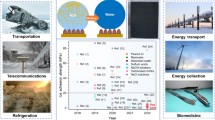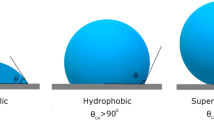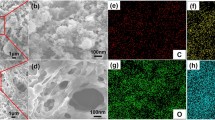Abstract
In this work, a simple and economic route was presented to fabricate an anti-icing superhydrophobic surface with nanocone structures, which were constructed only by one-step facile method of hydrothermal treatment with zinc acetate on the aluminum substrate. After modifying with fluoroalkylsilane (FAS-17), the nanocone structures with the appropriate size could induce the high superhydrophobicity with the water contact angle reaching 160.2° ± 0.4° and the sliding angle only being 1° ± 0.5°. Under the dynamic environments, the impact droplets could rapidly bounced off the surface with the shorter contact time of ~10.6 ms, and it was mainly attributing to lower capillary adhesive force (water adhesion force of 4.1 μN) induced by the open system of nanocone structures. Furthermore, the superhydrophobic nanocone surfaces were verified to be a promising anti-icing/icephobic materials, on which the water droplets needed to spend the time of ~517 s to complete the entire freezing process at −10 °C, displaying the increased ~50 times of icing-delay performance comparing with untreated substrate. Even if ice finally was formed on the superhydrophobic nanocone surfaces, it could be easily removed away with lower ice adhesion of ~45 kPa. The repeatable measurement of ice adhesion strength on the same place of the superhydrophobic surface is still far less than the surface ice adhesion of smooth substrate, exhibiting better stability.
Similar content being viewed by others
References
Laforte J L, Allaire M A, Laflamme J. State-of-the-art on power line de-icing. Atmospheric Research, 1998, 46, 143–158.
Whalen E A, Bragg M B. Aircraft characterization in icing using flight test data. Journal of Aircraft, 2005, 42, 792–794.
Cao Y, Huang J, Yin J. Numerical simulation of three-dimensional ice accretion on an aircraft wing. International Journal of Heat & Mass Transfer, 2016, 92, 34–54.
Politovich M K. Aircraft icing caused by large supercooled droplets. Journal of Applied Meteorology, 1989, 28, 856–868.
Wu W, Yi X, Guo M, Chen L. State of the art and practice of pavement anti-icing and de-icing techniques. Sciences in Cold and Arid Regions, 2014, 6, 14–21.
Habibi H, Cheng L, Zheng H, Kappatos V, Selcuk C, Gan T. A dual de-icing system for wind turbine blades combining high-power ultrasonic guided waves and low-frequency forced vibrations. Renewable Energy, 2015, 83, 859–870.
Shen Y, Wang G, Tao J, Zhu C, Liu S, Jin M, Xie Y, Chen Z. Anti-icing performance of superhydrophobic texture surfaces depending on reference environments. Advanced Materials Interfaces, 2017, 4, 1700836.
Chu H, Zhang Z, Liu Y, Leng J. Self-heating fiber reinforced polymer composite using meso/macropore carbon nanotube paper and its application in deicing. Carbon, 2014, 66, 154–163.
Zhang K, Han B, Yu X. Nickel particle based electrical resistance heating cementitious composites. Cold Regions Science and Technology, 2011, 69, 64–69.
Fu Y, Jiang J, Zhang Q, Zhan X, Chen F. Robust liquid-repellent coatings based on polymer nanoparticles with excellent self-cleaning and antibacterial performances. Journal of Materials Chemistry A, 2017, 5, 275–284.
Jung S, Tiwari M K, Doan N V, Poulikakos D. Mechanism of supercooled droplet freezing on surfaces. Nature Commu nications, 2012, 3, 615.
Shen Y, Tao J, Tao H, Chen S, Pan L, Wang T. Anti-icing potential of superhydrophobic Ti6Al4V surface: Ice nucleation and growth. Langmuir, 2015, 31, 10799–10806.
Liu M, Zheng Y, Zhai J, Jiang L. Bioinspired super-antiwetting interfaces with special liquid-solid adhesion. Accounts of Chemical Research, 2009, 43, 368–377.
Bormashenko E, Starov V. Impact of surface forces on wetting of hierarchical surfaces and contact angle hysteresis. Colloid and Polymer Science, 2013, 291, 343–346.
Li Y, Li L, Sun J. Bioinspired self-healing superhydrophobic coatings. Angewandte Chemie, 2010, 122, 6265–6269.
Blossey R. Self-cleaning surfaces-virtual realities. Nature Materials, 2003, 2, 301–306.
Shen Y, Liu S, Zhu C, Tao J, Wang G. Facile fabrication of hierarchical structured superhydrophobic surface and its ultra dynamic water repellency. Chemical Engineering Journal, 2017, 313, 47–55.
Accardo A, Gentile F, Mecarini F. Angelo A, Francesco G, Federico M, Francesco D A, Manfred B, Enzo D F, Christian R. Ultrahydrophobic PMMA micro-and nano-textured surfaces fabricated by optical lithography and plasma etching for X-ray diffraction studies. Microelectronic Engineering, 2011, 88, 1660–1663.
Shen Y, Tao J, Tao H, Chen S, Pan L, Wang T. Superhydrophobic Ti6Al4V surfaces with regular array patterns for anti-icing applications. RSC Advances, 2015, 5, 32813–32818.
Zhan X, Yan Y, Zhang Q, Chen F. A novel superhydrophobic hybrid nanocomposite material prepared by surface-initiated AGET ATRP and its anti-icing properties. Joumal of Materials Chemistry A, 2014, 2, 9390–9399.
Wang Y, Xue J, Wang Q, Chen Q, Ding J. Verification of icephobic/anti-icing properties of a superhydrophobic surface. ACS Applied Materials and Interfaces, 2013, 5, 3370–3381.
Zhang G, Zhang Q, Cheng T, Zhan X, Chen F. Polyols-infused slippery surfaces based on magnetic Fe3O4-functionalized polymer hybrids for enhanced multifunctional anti-icing and de-icing properties. Langmuir, 2018, 34, 4052–4058.
Ruan M, Li W, Wang B S, Deng B, Ma F, Yu Z. Preparation and anti-icing behavior of superhydrophobic surfaces on aluminum alloy substrates. Langmuir, 2013, 29, 8482–8491.
Saleema N, Sarkar D K, Gallant D, Paynter R W, Chen X G. Chemical nature of superhydrophobic aluminum alloy surfaces produced via a one-step process using fluoroalkyl-silane in a base medium. ACS Applied Materials and Interfaces, 2011, 3, 4775–4781.
Li M, Zhai J, Liu H, Song Y, Jiang L, Zhu D. Electrochemical deposition of conductive superhydrophobic zinc oxide thin films. Journal of Physical Chemistry B, 2003, 107, 9954–9957.
Buijnsters J G, Zhong R, Tsyntsaru N, Celis J P. Surface wettability of macroporous anodized aluminum oxide. ACS Applied Materials and Interfaces, 2013, 5, 3224–3233.
Li J, Wan H, Ye Y, Zhou H, Chen J. One-step process for the fabrication of superhydrophobic surfaces with easy repairability. Applied Surface Science, 2012, 258, 3115–3118.
Ogihara H, Xie J, Okagaki J, Saji T. Simple method for preparing superhydrophobic paper: Spray-deposited hydrophobic silica nanoparticle coatings exhibit highwaterrepellency and transparency. Langmuir, 2012, 28, 4605–4608.
Peng Y, Lo K, Juang Y. Constructing a superhydrophobic surface on polydimethylsiloxane via spin coating and vapor-liquid sol-gel process. Langmuir 2010, 26, 5167–5171.
Tang Y, Zhang Q, Zhan X, Chen F. Superhydrophobic and anti-icing properties at overcooled temperature of a fluorinated hybrid surface prepared via a sol–gel process. Soft Matter, 2015, 11, 4540–4550.
Chen L, Li Z. Bouncing droplets on nonsuperhydrophobic surfaces. Physical Review E, 2010, 82, 016308.
Feng L, Li S, Li Y, Li H, Zhang L, Zhai J, Song Y, Liu B, Jiang L, Zhu D. Super-hydrophobic surfaces: From natural to artificial. Advanced Materials, 2002, 14, 1857–1860.
Shi Y, Xiao X, Zhang W. Facile fabrication of superhydrophobic surface with needle-like microflower structure on aluminum substrate. Journal of Coating Technology and Research, 2015, 12, 1143–1151.
Liu P, Liu D, Liu Y, Li L. ANTS-anchored Zn-Al-CO3-LDH particles as fluorescent probe for sensing of folic acid. Journal of Solid State Chemistry, 2016, 241, 164–172.
He M, Zhang Q, Zeng X, Cui D, Chen J, Li H, Wang J, Song Y. Hierarchical porous surface for efficiently controlling microdroplets’ self-removal. Advanced Materials, 2013, 25, 2291–2295.
Lai Y, Tang Y, Gong J, Gong D, Chi L, Lin C, Chen Z. Transparent superhydrophobic/superhydrophilic TiO2-based coatings for self-cleaning and anti-fogging. Journal of Materials Chemistry, 2012, 22, 7420–7426.
Hozumi A, Takai O. Effect of hydrolysis groups in fluoro-alkyl silanes on water repellency of transparent two-layer hard-coatings. Applied Surface Science, 1996, 103, 431–441.
Brassard J D, Sarkar D K, Perron J. Synthesis of monodisperse fluorinated silica nanoparticles and their superhydrophobic thin films. ACS Applied Materials and Interfaces, 2011, 3, 3583–3588.
Schondelmaier D. Orientation and self-assembly of hydrophobic fluoroalkylsilanes. Langmuir, 2002, 18, 6242–6245.
Marmur A. Wetting on hydrophobic rough surfaces: to be heterogeneous or not to be? Langmuir, 2003, 19, 8343–8348.
Lafuma A, Quéré D. Superhydrophobic states. Nature Materials, 2003, 2, 457–460.
Medvid A, Onufrijevs P, Mychko A. Properties of nanocones formed on a surface of semiconductors by radiation: Quantum confinement effect of electrons, phones, and excitons. Nanoscale Research Letters, 2011, 6, 582.
Kim J. Droplet impact dynamics on lubricant-infused superhydrophobic surfaces: The role of viscosity ratio. Langmuir, 2016, 32, 10166–10176.
Bartolo D, Josserand C, Bonn D. Retraction dynamics of aqueous drops upon impact on non-wetting surfaces. Journal of Fluid Mechanics, 2005, 545, 329–338.
Reyssat M, Richard D, Clanet C, Quere D. Dynamical superhydrophobicity. Faraday Discussions, 2010, 146, 19–33.
Okumura K, Chevy F, Richard D, Quere D, Clanet C. Water spring: A model for bouncing drops. Europhysics Letters, 2003, 62, 237.
Wen M, Wang L, Zhang M, Jiang L, Y. Zheng Y. Antifogging and icing-delay properties of composite micro-and nanostructured surfaces. ACS Applied Materials and Interfaces, 2014, 6, 3963–3968.
Rykaczewski K, Anand S, Subramanyam S B, Varanasi K K. Mechanism of frost formation on lubricant-impregnated surfaces. Langmuir, 2013, 29, 5230–5238.
Cheng T, He R, Zhang Q, Zhan X, Chen F. Magnetic particles-based super-hydrophobic coatings with excellent anti-icing and thermoresponsive deicing performances. Journal of Materials Chemistry A, 2015, 3, 21637–21646.
Janjua Z A. The influence of freezing and ambient temperature on the adhesion strength of ice. Cold Regions Science and Technology, 2017, 140, 14–19.
Nosonovsky M, Hejazi V. Why superhydrophobic surfaces are not always icephobic. ACS Nano, 2012, 6, 8488–8491.
Acknowledgement
This work was supported by the National Natural Science Foundation of China (Nos. 51671105 and 51705244), the National Postdoctoral Program for Innovative Talents (BX201600073), the Project Funded by China Postdoctoral Science Foundation (2017M610329), the Natural Science Foundation of Jiangsu Province (No. BK20170790), Jiangsu Planned Projects for Postdoctoral Research Funds (No. 1701200B), General Project of Zhejiang Provincial Department of Education (Y201737320), the NUAA Innovation Program for Graduate Education (kfjj20170608, kfjj20180609) and A Project Funded by the Priority Academic Program Development of Jiangsu Higher Education Institutions.
Author information
Authors and Affiliations
Corresponding author
Rights and permissions
About this article
Cite this article
Xie, Y., Chen, H., Shen, Y. et al. Rational Fabrication of Superhydrophobic Nanocone Surface for Dynamic Water Repellency and Anti-icing Potential. J Bionic Eng 16, 27–37 (2019). https://doi.org/10.1007/s42235-019-0003-x
Published:
Issue Date:
DOI: https://doi.org/10.1007/s42235-019-0003-x




